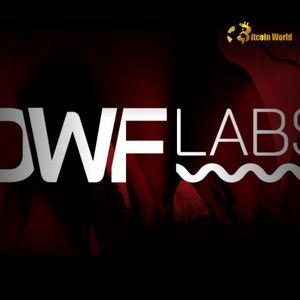Altcoin Investment: DWF Labs Proposes Revolutionary Bridge to Traditional Finance
5 min read
BitcoinWorld Altcoin Investment: DWF Labs Proposes Revolutionary Bridge to Traditional Finance Imagine a world where investing in your favorite altcoin is as straightforward as buying shares in a major company on Nasdaq. This isn’t just a futuristic fantasy; it’s a strategic vision proposed by a key player in the crypto space. Andrei Grachev, co-founder of prominent crypto market maker DWF Labs , recently sparked discussion with his idea that if Traditional Finance (TradFi) isn’t coming to altcoins quickly enough, then perhaps altcoins should make the move into TradFi territory. Why Bridge the Gap Between Altcoin Investment and Traditional Finance? The core of Grachev’s argument, shared via an X post, centers on boosting the overall Crypto Market Integration . He observes a potential bottleneck: while many hope for a massive influx of TradFi capital into the existing crypto market structure, it might be more effective for crypto projects themselves to build pathways directly into traditional investment vehicles. The goal is clear: tap into the vast pools of capital and the enormous investor base that reside within the traditional financial system. Think about the millions of investors who are comfortable buying stocks but find the world of crypto wallets, exchanges, and tokenomics complex or intimidating. By offering familiar investment structures, projects could significantly expand their reach. Grachev’s perspective, coming from a firm like DWF Labs which operates extensively in both centralized and decentralized markets, carries weight. Market makers are deeply involved in liquidity and trading, understanding the mechanics of how assets move and how investor sentiment impacts markets. Their view on bridging these worlds is informed by practical experience in facilitating large-scale transactions. How Could Altcoins Enter the Traditional Finance Realm? Grachev’s specific proposal involves creating “Nasdaq listed vehicles” for crypto projects. This concept suggests structures similar to exchange-traded funds (ETFs) or other publicly traded instruments that hold or represent altcoins. Here’s a breakdown of the potential mechanism: Creating the Vehicle: A legal and financial structure is established, perhaps a trust or corporation, that is compliant with securities regulations in jurisdictions like the US. Acquiring the Asset: This vehicle would acquire and hold the underlying altcoin or a basket of altcoins. Listing on Nasdaq: Shares of this vehicle are then listed and traded on a major stock exchange like Nasdaq, making them accessible through standard brokerage accounts. Attracting TradFi Investors: Traditional investors can now gain exposure to the altcoin’s price movement by buying shares of this listed vehicle, using platforms they already trust. Converting Shareholders to Token Holders: This is a unique part of Grachev’s idea. He suggests a mechanism to “covert [investors] to long term token holders via selling the shares.” This could imply an option or incentive for shareholders to redeem their shares for the underlying tokens after a certain period, potentially moving them from a regulated TradFi wrapper into direct crypto ownership. This approach addresses a key hurdle in Digital Asset Adoption : ease of access and regulatory clarity. Traditional investors are accustomed to the regulatory oversight and investor protections associated with stock markets. Offering a compliant, listed product removes many perceived risks and complexities associated with direct crypto ownership. What are the Potential Benefits? Should altcoins successfully build these bridges into Traditional Finance , the potential benefits for the crypto ecosystem are significant: Massive Capital Influx: Unlocking trillions of dollars held by institutions, pension funds, and retail investors in traditional markets. Increased Liquidity: Higher trading volume and deeper order books for altcoins as more capital flows in. Enhanced Legitimacy: Listing on major exchanges lends credibility and mainstream acceptance to altcoins and the broader crypto market. Broader Investor Base: Reaching a demographic of investors currently outside the crypto native community. Potential for Price Appreciation: Increased demand driven by new capital can positively impact altcoin valuations. Innovation in Financial Products: Creating new hybrid financial instruments that blend aspects of traditional and digital assets. This strategic pivot could fundamentally change the scale and perception of Altcoin Investment . Are There Challenges to Crypto Market Integration via TradFi? While the vision is compelling, executing such a strategy for Crypto Market Integration faces considerable challenges: Regulatory Hurdles: Securities regulators globally have complex rules regarding digital assets. Structuring compliant vehicles and navigating listing requirements is difficult and time-consuming. Technical Complexity: Managing the underlying altcoin assets, ensuring secure custody, and facilitating potential conversions from shares to tokens adds layers of technical and operational complexity. Market Volatility Perception: Traditional investors may still be wary of the inherent volatility of altcoins, regardless of the wrapper. Educating Investors: Even within a familiar structure, educating traditional investors about the specific risks and opportunities of individual altcoins is crucial. Project Willingness: Not all altcoin projects may be willing or able to go through the rigorous process required for a Nasdaq listing or similar TradFi integration. Custody and Security: Ensuring the security and integrity of the underlying digital assets held by the listed vehicle is paramount. Successfully navigating these challenges requires significant expertise, capital, and collaboration between crypto projects, financial institutions, and regulators. The role of entities like DWF Labs , with their market expertise, could be crucial in facilitating such complex structures. The Future of Digital Asset Adoption: A Two-Way Street? Grachev’s proposal highlights a proactive approach to Digital Asset Adoption . Instead of solely waiting for TradFi to adapt to crypto’s structure, crypto projects can adapt to TradFi’s structure to accelerate access to capital and investors. This doesn’t mean the traditional path of direct crypto ownership goes away. Rather, it suggests creating parallel on-ramps that cater to different investor preferences and risk appetites. For many, buying a share on Nasdaq might be the first, comfortable step towards engaging with digital assets, potentially leading them to explore direct ownership later. The idea underscores a growing maturity in the crypto space, where participants are exploring diverse strategies for growth and mainstream relevance. It’s a recognition that mass adoption may require meeting traditional finance halfway, building bridges rather than expecting a complete migration. Conclusion: A Bold Vision for Altcoin Investment Andrei Grachev’s suggestion that altcoins should proactively enter the Traditional Finance world via listed vehicles is a bold and potentially game-changing idea. It represents a strategic shift from waiting for TradFi to fully embrace existing crypto structures to building new pathways within the familiar landscape of traditional markets. While significant challenges related to regulation, technology, and market perception exist, the potential rewards – unlocking vast capital, increasing legitimacy, and accelerating Digital Asset Adoption – are immense. As the crypto market matures, expect more innovative proposals like this one, aimed at blurring the lines between traditional and digital assets and driving the next wave of Altcoin Investment and Crypto Market Integration , perhaps guided by firms like DWF Labs . To learn more about the latest crypto market trends, explore our articles on key developments shaping Altcoin Investment and Digital Asset Adoption . This post Altcoin Investment: DWF Labs Proposes Revolutionary Bridge to Traditional Finance first appeared on BitcoinWorld and is written by Editorial Team

Source: Bitcoin World



